December 2024 U.S. Transportation Sector Unemployment (4.3%) Was the Same As the December 2023 Level (4.3%) And Above the Pre-Pandemic December 2019 Level (2.8%)
3 hours ago
The unemployment rate in the U.S. transportation sector was 4.3% (not seasonally adjusted) in December 2024 according to Bureau of Labor Statistics (BLS). These data have been updated on the Bureau of Transportation Statistics’ (BTS) Unemployment in Transportation dashboard. In December 2024, the transportation sector unemployment rate remained unchanged from 4.3% in December 2023 and was above the pre-pandemic December 2019 level of 2.8%. Unemployment in the transportation sector reached its highest level during the COVID-19 pandemic (15.7%) in May 2020 and July 2020.
Unemployment in the transportation sector was higher than overall unemployment. BLS reports that the U.S. unemployment rate, not seasonally adjusted, in December 2024 was 3.8% or 0.5 percentage points below the transportation sector rate. Seasonally adjusted, the U.S. unemployment rate in December 2024 was 4.1%.

Seasonally adjusted, employment in the transportation and warehousing sector rose to 6,630,200 in December 2024 — up 0.1% from the previous month and up 1.7% from December 2023. Employment in transportation and warehousing grew 15.1% in December 2024 from the pre-pandemic December 2019 level of 5,760,300. By mode (seasonally adjusted):
- Air transportation rose to 578,000 in December 2024 — up 0.4% from the previous month and up 1.4% from December 2023.
- Truck transportation fell to 1,545,900 in December 2024 — down 0.1% from the previous month and down 0.4% from December 2023.
- Transit and ground passenger transportation rose to 456,000 in December 2024 — up 0.3% from the previous month and up 5.7% from December 2023.
- Rail transportation remained virtually unchanged in December 2024 at 150,300 from the previous month but down 1.8% from December 2023.
- Water transportation rose to 74,300 in December 2024 — up 0.1% from the previous month and up 4.8% from December 2023.
- Pipeline transportation rose to 55,000 in December 2024 — up 0.5% from the previous month and up 6.2% from December 2023.
- Warehousing and storage rose to 1,770,300 in December 2024 — up 0.1% from the previous month and up 0.2% from December 2023.

NOTES: December 2019 and December 2024 employment (seasonally adjusted) not shown for water (67,300 and 74,300, respectively) or pipeline (52,000 and 55,000, respectively) transportation. All-time highs (seasonally adjusted) with records beginning in 1990: air March 2001 (633,600); pipeline July 1991 (61,200); rail January 1990 (278,100); transit June 2019 (503,900); truck July 2022 (1,587,900); warehousing and storage May 2022 (1,942,200); and water June 2024 (75,800)
In addition to updating the Unemployment in Transportation and the Employment in Transportation: Total, by Mode, and Women dashboards, BTS also updated the Race and Hispanic or Latino Ethnicity of Transportation Workers dashboard.
Charts updated this month by section include:
Unemployment in the Transportation and Warehousing Sector and in Transportation and Material Moving Occupations
Monthly Employment in the Transportation and Warehousing Sector, Establishment Data
- Monthly Employment in the Transportation and Warehousing Sector
- Monthly Employment in the Transportation and Warehousing Sector by Mode
- Women Workers in the Transportation and Warehousing Sector
Monthly Employment in the Transportation and Warehousing Sector by Race and Hispanic or Latino Ethnicity, Household Data
Visit Transportation Economic Trends for more topics.
The unemployment rate is the total number of unemployed persons, expressed as a percentage of the civilian labor force. The civilian labor force includes all persons aged 16 and older who are employed and unemployed; meaning they are either currently working or actively looking for work. Unemployed persons include those who actively sought a job within the last four weeks. People waiting to start a new job who have not actively sought a job in the last four weeks are not counted as employed or unemployed; they are considered to be out of the labor force.
An unemployed person’s industry is the industry for the last job they held in the workforce, which may or may not reflect their current job search field or industry.
Similar Stories
DP World appoints Jason Haith as Vice President of Freight Forwarding for U.S. and Mexico
DP World, a global leader in logistics and supply chain solutions, has announced the appointment of Jason Haith as Vice President, Commercial Freight Forwarding – U.S. and Mexico, effective immediately.…
View Article
Amaero secures final approval for $23.5M loan from Export-Import Bank
View ArticleU.S. Bureau of Labor Statistics employment situation
Total nonfarm payroll employment increased by 256,000 in December, and the unemployment rate changed little at 4.1 percent, the U.S. Bureau of Labor Statistics reported today. Employment trended up in…
View ArticleImport Cargo to remain elevated in January
A potential strike at East Coast and Gulf Coast ports has been avoided with the announcement of a tentative labor agreement, but the nation’s major container ports have already seen…
View ArticleS&P Global: 2025 U.S. transportation infrastructure sector should see generally steady demand and growth
S&P Global Ratings today said it expects activity in the U.S. transportation sector will continue to normalize in 2025, with growth rates for most modes of transportation slowing to levels…
View Article
CBP officers seize counterfeit Tiffany & Co. jewelry
View ArticleGet the most up-to-date trending news!
SubscribeIndustry updates and weekly newsletter direct to your inbox!





